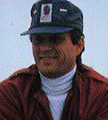 Dr. Robert D. Ballard
Dr. Robert D. Ballard Dr. Robert D. Ballard
Dr. Robert D. BallardWhile doing postgraduate work in marine geology at the University of Hawaii, he worked as a porpoise trainer at a nearby marine park and taught dolphins to dive through hoops and perform other tricks. In 1967, he entered the U.S. Navy and was assigned to the Deep Submergence Laboratory at Woods Hole, where he remained ever since.
Robert Ballard has led or participated in over 65 underwater expeditions, some of them involving the use of deep-diving submersibles. He made many of his dives in the Alvin, a small, three- person submarine. In 1973 and 1974, he explored the Mid-Atlantic Ridge, a huge underwater mountain range in the middle of the Atlantic Ocean. This ridge is part of a larger undersea range that extends 64,000 kilometers (40,000 miles) around the globe.
In 1977, near the Galapagos Islands off the coast of Ecuador, Dr. Ballard and his crew discovered giant worms, some more than two and a half meters (eight feet) long, living inside white tubes and clustered around underwater hot springs. In 1979, he found black smokers off the coast of Baja California. These underwater volcanoes erupt with hot fluids that shoot up from the sea floor through chimneys formed by mineral deposits.
In 1985, Dr. Ballard and his research team made their most famous discovery--the wreck of the R.M.S. Titanic. He and his colleagues designed a robot, the Jason Jr., to enter the Titanic and photograph its interior. As a result of this successful venture, Dr. Ballard planned the JASON Project so that thousands of students could share the excitement of live exploration. In 1989, Dr. Ballard took approximately 200,000 students by telepresence to the bottom of the Mediterranean Sea, where they saw underwater volcanoes, artifacts, and the remains of ancient trading vessels. On the return trip he located the German battleship Bismarck off the coast of France. In 1990, year two of the JASON Project, Dr. Ballard, his crew, and JASON explored the wrecks of the Hamilton and Scourge, armed schooners that sank in Lake Ontario during the War of 1812. In 1991, year three of the JASON Project, Dr. Ballard, his crew, two ROVs, and a team of biologists, herpetologists, and geologists explored the Galapagos Islands above and below the water.
Dr. Ballard has written many scientific articles and books about his explorations. He is the author of Exploring Our Living Planet, The Discovery of the Titanic, Discovery of the Bismarck, The Children's Explorer Pop-Up Book, and the science fiction novel Bright Shark. He has received many distinguished awards from universities, museums, scientific societies, and explorers' clubs. He has appeared in numerous television programs, including three National Geographic specials.
Robert Ballard is committed to exploring the least-known portions of our planet--the regions that lie under water. According to Dr. Ballard, we are in the Lewis-and-Clark stage of exploration of these regions. He compares viewing the ocean floor with walking on the moon. In more than 20 years of exploration, Robert Ballard has seen more of the ocean floor than anyone alive. When he's not exploring under water, he enjoys skiing, whitewater rafting, fishing, and spending time with his son.
![]()
![]()
JASON Project homepage ||
Teachers' Guide ||
Students' Corner ||
Search
Gene Carl Feldman
(gene@seawifs.gsfc.nasa.gov)
(301) 286-9428
Todd Carlo Viola, JASON Foundation for Education (todd@jason.org)
Revised: 17 Oct 1995